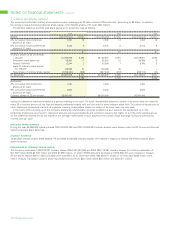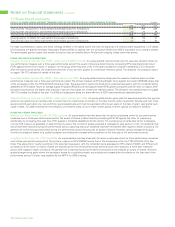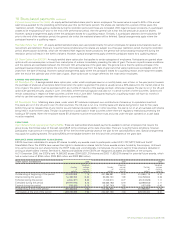BP 2005 Annual Report Download - page 164
Download and view the complete annual report
Please find page 164 of the 2005 BP annual report below. You can navigate through the pages in the report by either clicking on the pages listed below, or by using the keyword search tool below to find specific information within the annual report.
162 Making energy more
Process and activities in 2005 This committee has a broad remit
because it covers all non-financial risks and must necessarily be
selective in setting its agendas. These are focused on regular
reports – such as health, safety and environment (HSE) reviews and
compliance and ethics certification reports – that allow the committee
to monitor and assess the observance of the executive limitations. In
addition, the committee reviews specific risks that are identified in the
company’s annual plan and developments in business and functional
areas that may emerge during the year. During 2005, the committee
met specially to consider the incident at the Texas City refinery. It
reviewed the causes of the accident and the implications for the group
of the lessons to be learned. The committee continues to monitor the
executive management’s response and the strengthening of its safety
and operational capability.
Other areas of specific focus during the year included:
Business continuity and crisis management The committee
received reports and reviewed the group’s enhanced focus on
bringing more consistency and resilience to these linked topics
across all business segments and functions.
Health, safety and environmental performance While overshadowed
by events at Texas City, the progress in addressing road safety,
employee health, greenhouse gas emissions, oil spills and plant
integrity was considered during 2005. Specific attention was
given to the progress made by TNK-BP in improving HSE standards
in its operations in Russia.
Regional reviews Most board-level monitoring is conducted through
a business segment or functional dimension, but the committee
also examines risks that require management at regional or country
level. In 2005, risk reviews were undertaken for Africa, the Middle
East and Alaska.
Digital security The committee considered the company’s response
to the increasing international threats to communications and
computing, threats heightened by the convergence and increased
interconnectivity of technology infrastructure.
REMUNERATION COMMITTEE REPORT
Schedule and composition The committee met six
times during 2005 and comprised the following directors:
Dr D S Julius (chairman), J H Bryan, E B Davis, Jr,
Sir Tom McKillop, Sir Ian Prosser, Sir Robin Nicholson
(retired at the AGM), C F Knight (retired at the AGM).
All members of the remuneration committee are non-executive
directors and are considered by the board to be independent.
The chairman of the board also attends committee meetings.
The committee is independently advised.
Role and authority The committee’s main task is to determine the
terms of engagement and remuneration of the executive directors.
Process and activities in 2005 Full details of the committee’s remit and
work are set out in the directors’ remuneration report on pages 164-173,
which is the subject of a vote by shareholders at the 2006 AGM.
CHAIRMAN’S COMMITTEE REPORT
Schedule and composition The chairman’s committee
met four times during 2005 and comprised all the non-
executive directors.
Role and authority The task of the committee is to
consider broad issues of governance, including the performance of the
chairman and the group chief executive, succession planning, the
organization of the group and any matters referred to it for an opinion
from another board committee.
Process and activities in 2005 At its various meetings, the
committee evaluated the performance of the chairman and the group
chief executive, considered the plan for executive succession and
Employee concerns reporting/whistleblowing The committee
received regular reports of the matters raised through the
employee concerns programme, OpenTalk, and, through this
process, together with the receipt of quarterly fraud reports
from internal audit, was alerted to instances of actual or potential
concern related to the finances and financial accounting
of the group.
External auditors In addition to the lead partner’s attendance at
all meetings, the committee regularly invited other relevant audit
partners to participate during business segment reviews. Private
meetings were held without executive management present.
The committee evaluated the performance of the external auditors
and enquired into their independence, objectivity and viability.
Independence was safeguarded by limiting non-audit services
provided by the auditor to defined audit-related work and tax
services that fall within specific categories. All such services were
pre-approved by the committee and monitored quarterly. A new lead
audit partner is appointed every five years, with other senior audit
staff rotating every seven years; no senior staff connected with the
BP audit may transfer to the company.
After review of the audit engagement terms and proposed
fees, the committee advised the board of its assessment and
recommended that reappointment of the auditors be proposed
to shareholders at the 2005 AGM.
Internal audit The committee agreed with the BP general auditor
the programme to be undertaken during the year and the resources
required. Twice-yearly reports of audit findings and management
responses were reviewed in detail. Discussions of these reports
contributed to the committee’s view of the effectiveness of the
company’s system of internal controls and hence its advice to the
board on this matter. The committee also met privately with the BP
general auditor, without the presence of executive management, and
evaluated the performance of the function.
Performance evaluation On an annual basis, the committee conducts
a review of its process and performance. The form of review varies
to encourage fresh thinking and this year involved face-to-face
interviews with individual members and with others in regular
attendance. Outcomes were discussed at the committee’s November
meeting. The committee concluded that few substantive changes
were required but used the discussion to help shape the 2006
forward agenda and in particular to increase the frequency of the
committee’s private meetings.
ETHICS AND ENVIRONMENT ASSURANCE
COMMITTEE REPORT
Schedule and composition The committee met seven
times during 2005 and comprised the following directors:
Dr W E Massey (chairman), A Burgmans, H M P Miles,
M H Wilson.
All members of the ethics and environment assurance committee
are independent non-executive directors. The external auditors’ lead
partner and the BP general auditor (head of internal audit) attend
each meeting at the request of the committee chairman.
Role and authority The task of the committee is to monitor on
behalf of the board matters relating to the executive management’s
processes to address environmental, health and safety, security and
ethical behaviour issues. The committee monitors the observance
of the executive limitations relating to non-financial risks to the group.
Just as for the audit committee, it has the right to request any
information from the executive management that it considers
necessary to discharge its functions. The committee chairman reports
on the committee’s activities to the board meeting immediately
following a committee meeting.
























